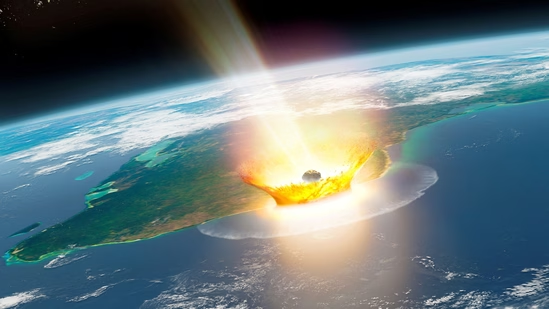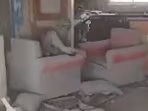Interstellar armageddon: NASA's plan to blast ‘planet killer’ asteroids revealed
66 million years ago, a dinosaur-killing asteroid dramatically changed the fate of the Earth, resulting in the estimation of what is now estimated as 75% of animal species, including most dinosaurs. With that insight, scientists have some plans in place to deal with a potential apocalyptic catastrophe in case a planet-killing asteroid rains down on the planet.

Last year, NASA released the National Preparedness Strategy and Action Plan for Near-Earth Objects and Hazards and Planetary Defence, detailing how it plans to counter-strike a Near-Earth Object (NEO). The interstellar clash of the Titans-esque strategy entails blasting the doomsday-causing object with a “1,000-strong army of spacecraft - or even a nuke,” per The US Sun’s report.
Also read | ‘God of Chaos’ Friday 13th astronomic scare in the making: Giant asteroid could hit Earth despite previous negations
At the moment, no such scenario poses a life-altering risk to the planet for at least a century, as NASA already has some of the most dangerous asteroids that could hit Earth in the future on its radar. Nevertheless, the US government agency also acknowledges that dozens of these “planet killer” asteroids could be lurking in space without their knowledge.
NASA's plans to divert a potential ‘planet killer’ asteroid from its path
Firing up its slew of experiments in the field, NASA locked its sights on kinetic impactors, i.e. high-speed spacecraft that could slam into the hazardous rock, pushing it off its collision course. In 2022, the agency went ahead with testing its $325 million Double Asteroid Redirection Test (DART). The experiment targetted a 580 ft-wide cluster of rock - Dimorphos - orbiting the bigger threat, Didymos. Rocket “Hera” was successfully launched, and it slammed into the pair of rocks, slowing them down by 30 minutes.
Although these cosmic rocks didn’t actually pose a cataclysmic threat to the planet, the test marked the first-ever attempt to push an asteroid off its original trajectory. In the aftermath, experts realised that such an impact birthed further risks of fragments detaching from the giant asteroid and charting an unpredictable journey of their own. As a result, targeting something as big as about 2,000 ft wide required experts to fire off nearly 100 rockets. Therefore, deflecting an asteroid with the potential of a dinosaur-killing planetoid would need over 1,000 spacecraft.
Nuclear Explosive Device is the second option
Another alternative to the 1,000 spacecraft mission would mean going full ‘Armageddon,’ as in the 1998 sci-fi action flick, and nuking the asteroid before it smashes into Earth. NASA’s report stated that some special situations would inevitably call for the nuclear explosion method to save the world. “It is still possible that discovery of either even a relatively small object less than a few months to years before impact or a relatively large or fast-trajectory object would create a situation when only use of a nuclear explosive device (NED) would provide sufficient force to either deflect or disrupt the impactor in time to mitigate devastating effects on Earth.”
Also read | SpaceX successfully ‘catches’ Starship rocket booster in rare engineering feat
Another study estimated that scientists would need a nuclear bomb 200 times more powerful than the bomb that consumed Hiroshima if they intended to go up against a 650ft asteroid. “A single appropriately sized nuclear explosive device was, in our analysis, found to be capable of deflecting even the 1.5-kilometre size asteroid,” aerospace engineer Brent Barbee told Live Science.
He continued, “Space, of course, is a vacuum. So you don't get a big pressure wave or any of the thermal effects of a terrestrial detonation. You get a whole lot of radiation all at once.”
Worst case scenario: A ‘planet killer’ slams into Earth, what next?
As for what would happen if a planet-destroying asteroid does hit Earth, Dr Steven Goderus, a research professor of chemistry at Vrije Universiteit Brussel and the coauthor of a new study discussing the chemical identity of the dino killer Chicxulub asteroid, said, “All this kinetic energy is converted into heat.” Notably, the 66 million-year-old rock, roughly Mount Everest’s size, travelled towards Earth at 15.5 miles per second (25 kilometres per second), according to NASA.
Goderis went on to say, “When the thing hits the target, it will more than explode; it will be vaporized,” as CNN reported. The impact ultimately resulted in a cloud of dust made of the asteroid and the rock it landed on. This dusty creation then spread worldwide and blocked out the sun, causing temperatures to drop significantly for years in light of an “impact winter, finally leading to mass extinction.
Disclaimer: The copyright of this article belongs to the original author. Reposting this article is solely for the purpose of information dissemination and does not constitute any investment advice. If there is any infringement, please contact us immediately. We will make corrections or deletions as necessary. Thank you.
Title:Interstellar armageddon: NASA's plan to blast ‘planet killer’ asteroids revealed
Url:https://www.investsfocus.com









